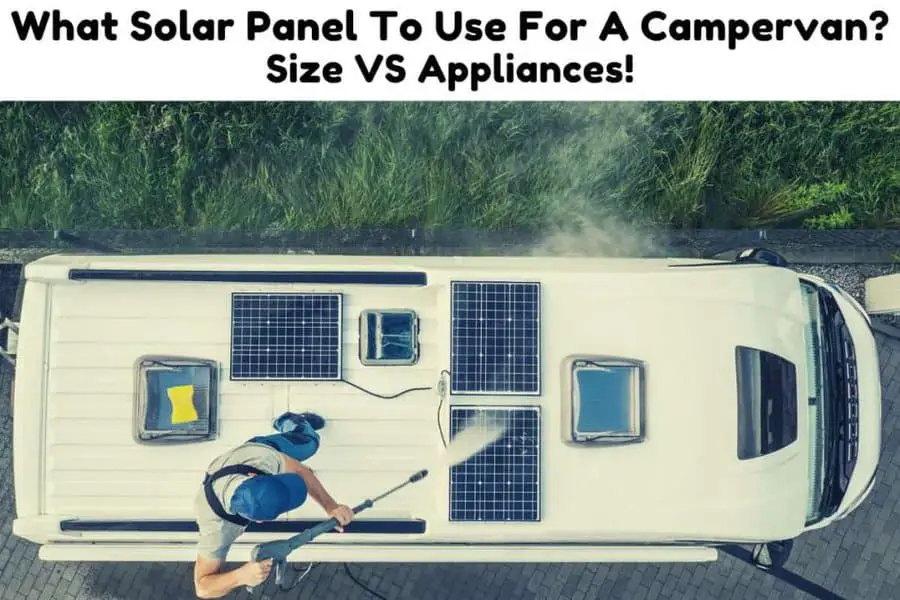Fully electric RVs with a long driving range, onboard hydrogen fuel cells, and fitted solar roofs may be just around the corner. If successfully introduced, they could drastically reduce the cost of owning a motorhome.
Until these futuristic campers hit the road, how do you power your motorhome for cheaper? Solar panels are a cost-effective, environmentally friendly way to power your camper on the go. But what type of solar panels do you need and how many should you get?
In this article, we will go over what you need to know to pick the right type and size of a solar panel for your campervan. If you were considering using solar panels for your RV’s energy needs but were unsure what to get then you are in the right place.

What Size Solar Panel Do I Need To Run My Camper?
The size of solar panels needed to run a camper is largely dependent on energy demand. The greater the energy use, the more solar panels will be required to meet the demand. Solar panels vary in size from small 10-watt solar panels that can be used to charge a mobile device to large 400-watt solar panels that can power an air conditioning system.
On a side note! If you’re in need of a reliable and high-performance portable solar panel, We strongly recommend the Jackery SolarSaga 100W Portable Solar Panel (Amazon Link).
With a high conversion efficiency and foldable design, this solar panel is easy to transport and set up, making it perfect for outdoor activities like camping, hiking, and RV trips.

The US solar cell technology used in this panel ensures that you get the most efficient and reliable solar charging possible.
There is also a 60W option that is more affordable (Amazon Link)
A solar panel consists of a group of solar cells wired together. There are either 60 or 72 solar cells in a panel. 72 solar cell panels are bigger, at roughly 6.6 by 3.25 feet. These are the solar panels typically used in large commercial installations since they have a higher energy yield.
60-cell solar panels are smaller at 5.5 by 3.25 feet. These are the solar panels used for residential applications and motorhomes. Source
The size in dimensions of a solar panel is not as important as the size in terms of its power capacity. However, you want to consider both as you have limited roof space on a camper.
How Many Watts Solar Panels Do I Need For A Camper?
Working out the watt requirement of solar panels for a camper depends on energy consumption and location. The primary factor is consumption. If the consumption is on the lower end, then a lower-watt solar panel can be used. If it is on the higher end due to the use of high consumption appliances such as cookers or air conditioning then higher watt solar panels are required.
In simple terms, how many watts you need for your camper depends on how much energy your camper uses. The average camper uses up to 20 kWh per day. That is as much as your typical residential home. Source
The consumption is split mostly between space heating and air conditioning as these two typically use up the most energy in just about any home whether on four wheels or not. Here is a breakdown of consumption in most campers.
| APPLIANCE | ENERGY USE (AMPS) |
|---|---|
| Air conditioning | 13-16 |
| Space heater | 7-13 |
| Water heater | 8-13 |
| Microwave | 13-15 |
| Refrigerator | 5-8 |
| Laptop | 2-3 |
| Mobile chargers | 0.5-1.5 |
While this is typically what you will find, your consumption will vary based on what appliances you own and frequently use. Hair dryers, kettles, or freezers will tilt your consumption either way of the average.
Before you can get an accurate idea of what size solar panels you will need you should first work out your consumption. You can do this by totaling up the consumption of each appliance and multiplying it by the number of hours you use it.
Taking 20-kilowatt hours as an average, it might be difficult to go completely off-grid using solar panels. The limited roof space of a camper would mean you could only have a few solar panels compared to your actual needs.
If for instance, you were able to install five 400-watt solar panels on your camper and they each received five hours of sunlight a day, that would give you total production of 10-kilowatt hours.
If your camper is in a sunny location, you can expect to have a higher energy yield from your solar panels than if you are in a cooler site. The more sun there is, the more light there is for solar panels to convert to energy.
Is 100w Solar Panel Enough For RV?
A single 100-watt solar panel can supply an RV with enough energy to run smaller appliances such as lights and mobile device chargers. Multiple 100-watt solar panels can be wired together to produce enough energy to power larger loads such as refrigerators and televisions.
A 100-watt solar panel would not be the most efficient choice for an RV due to the limited roof space. A more efficient use of space would be to have higher-watt solar panels.
If you had five 100-watt solar panels and they received five hours of sunlight, you would only get a total of 2.5-kilowatt hours of energy per day. If, however, you used that same roof space to put five 400-watt solar panels you would have 10-kilowatt hours per day. That’s four times as much energy from the same roof space just by using higher-watt solar panels.
It’s also a smart idea to make your RV more energy efficient before you get solar panels. This means the energy produced by your solar panels does not go to waste. The best ways to make an RV more energy efficient are to:
- Improve the insulation. A substantial amount of energy is used in heating and cooling an RV. This can be reduced with proper insulation. Sealing air leaks, caulking windows, and using skirting around your RV can make a big improvement on insulation.
- Use energy-efficient appliances.
What Can A 300-watt Solar Panel Run?
A 300-watt solar panel can run any appliance with a power consumption of fewer than 300 watts. This can be anything from a refrigerator to a television or a laptop charger. A 300-watt solar panel will produce as much as 1.5-kilowatt-hours of energy in a day.
The amount of energy a solar panel produces is a factor of its power rating measured in watts and the number of peak sunlight hours it receives. The higher the power rating and the more sunlight hours it receives, the more energy it produces. A 300-watt solar panel that receives 5 hours of peak sunlight will produce 1.5-kilowatt hours of energy.

